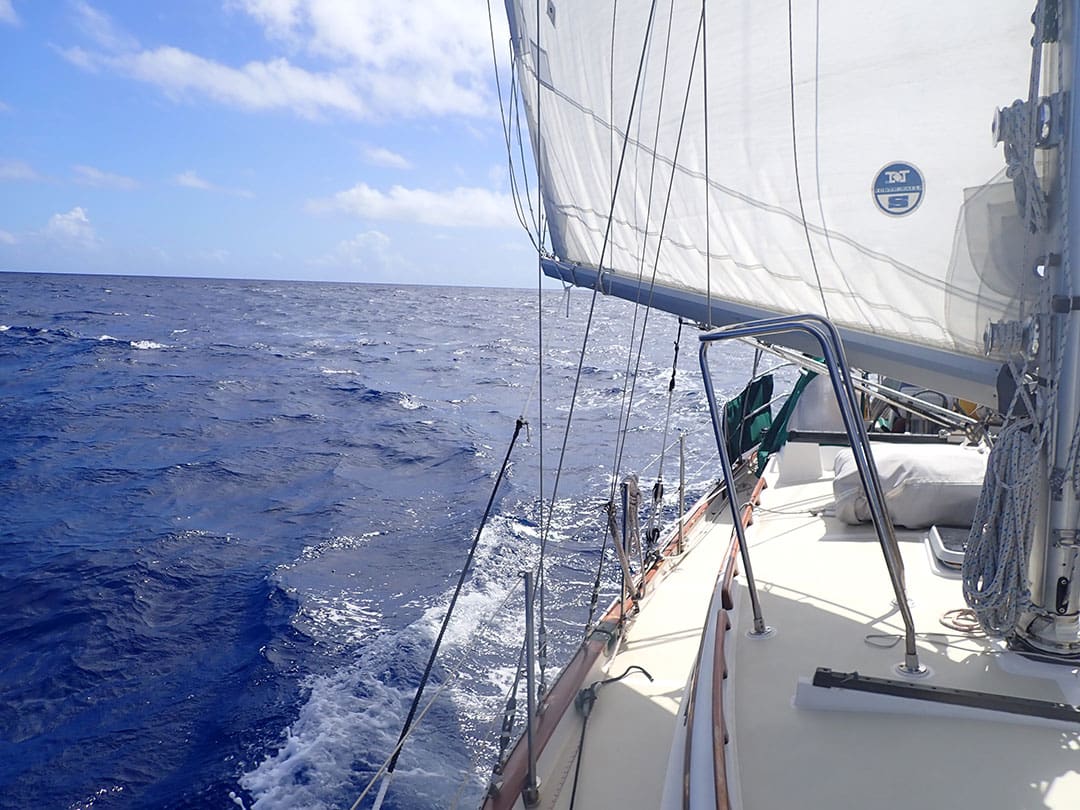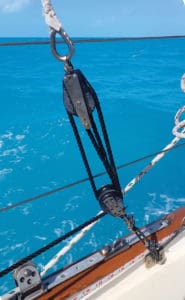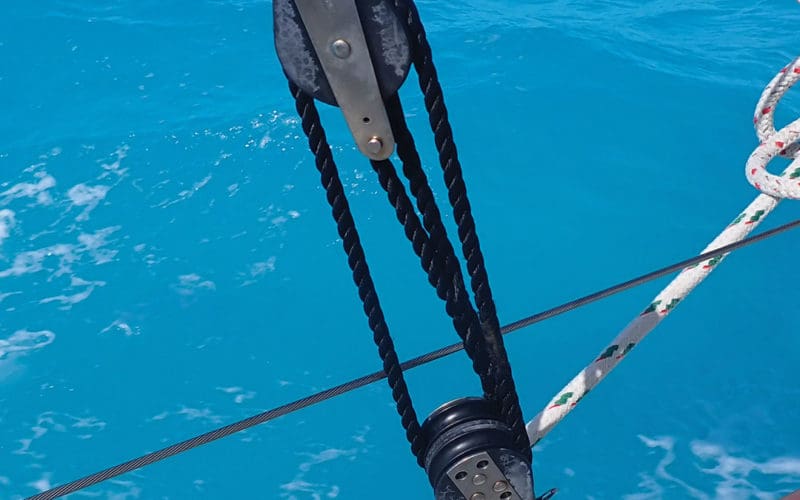
In 2016 my wife and I bought a 34-foot Cabo Rico, upgrading from the 27-foot Albin Vega we’d owned for 16 years. While we certainly appreciated the increase in speed, sea keeping and accommodation, gybing the big boat was a real challenge.
We have solved that problem with twin boom tackles, one to port, one to starboard. Not only do these let us simply ease the boom over when we gybe — no need to touch the main sheet — but each tackle acts as an instantly available preventer against an accidental gybe. The tackles let us haul down on the boom, improving speed and mainsail stability on any point of sail from a close reach to a run. Finally, by preventing the boom from lifting, the main’s chafe on the shrouds is much reduced.

Using a boom tackle to the rail as a means of controlling the boom is an idea at least centuries old, and the set-up is simple. A boom tackle on a boat of any size needs mechanical advantage, either a single line led to a spare winch, a block and tackle, or perhaps a combination. Our boom tackles are three-part, with a single block at one end and a double becket block at the other. The single block attaches to a short (about 18-inch) nylon pennant, which in turn is snap-shackled to a strong bail on the boom, about halfway down the boom’s length. The double block is shackled to a strong point by the rail near the after lower shroud. Rope of appropriate diameter (the “falls” of a block and tackle) is spliced to the becket on the double block, led to the single block on the boom, back to the double block, then aft to a cleat on the cockpit coaming. Another essentially identical tackle is rigged on the opposite side of the boat.
Suppose we are broad reaching in a strong wind. The lee boom tackle is hauled in hard, resulting in a flat main, stable and fast. Between the main sheet and the boom tackle, the main is locked in, fully controlled. The tackle will prevent the boom from coming over if there is an accidental gybe. The windward or lazy tackle is slacked, and draped across the cabin top.
Preparing to gybe
When we want to gybe, one of us takes the lee boom tackle off its cleat, keeping a turn on for control. The helmsman gybes the boat, and when the main backwinds, the boom tackle is used to ease the boom over. As soon as the boom is over, the new lee boom tackle is snugged up and secured, a matter of a few seconds, safeguarding against the boom sweeping over in an accidental gybe.
That’s all there is to it. One skilled sailor can gybe the boat, although it’s easier with two. We typically don’t touch the main sheet while gybing — the boom is controlled with only the boom tackle.
I believe it is important to have some nylon in the system, to prevent shock loading. One of my tackles has a dacron falls and, for stretch, an 18 inch, 5/16-inch nylon pennant attached to the boom bail. I used 5/16 for the pennant, which by appearances is a little light, to achieve the stretch which larger diameter line would lack. The other tackle is all nylon. It works just as well — stretch is not an issue in this application, as it would be for a sheet or a halyard — and, in fact, may impose less strain on the boom, obviously a concern.
I’m not sure which arrangement is best, all nylon, or Dacron with a nylon pennant. Both tackles have proven to work well. I conceived the heavier Dacron gear to be a better all-purpose block and tackle, what was once called a handy billy. Topped up on a halyard, for example, it could be used to retrieve a person from the water, where the stretchy all-nylon version would not work so well.
The all-nylon tackle is a bit trickier to surge around the cleat when gybing. A solution we use on both tackles, when we are preparing to gybe in strong winds, is to take the falls off the cleat and lead it directly to the adjacent sheet winch. (On our boat this requires casting off the jib sheet, which when before the wind poses no issue if one simply takes the slack out of the windward sheet.) It is much easier and safer to surge a loaded line around a winch than to surge that same line around a horn cleat.
When I first rigged these tackles, I terminated the double block at a moveable padeye on the jib track. I no longer do that because, although it has not happened to us, I worry that a high load, maybe a shock load, could bend or even lift the track. Now the double block of each tackle secures to a short Dyneema strop, doubled through a beefy midships mooring cleat.
Tested at sea
I recently completed a double-handed 400-mile passage from the Chesapeake to Charleston. Winds were more or less north the whole time, 20 to 35 knots, so we were running or broad reaching in a breeze of wind. We gybed many times, and the boom tackles made the maneuver safe, efficient and fast. Only for the few seconds it took to take in the new lee boom tackle, after each gybe, was the boom not secured against an accidental gybe. That’s a great comfort when running in a seaway.
I have a traditional preventer which when rigged leads from the end of the boom to the bow and then aft, but on this passage we hardly used it, and I am not sure the additional protection afforded by the traditional preventer offsets the inconvenience and risk of having to bring the preventer over — requiring a trip to the bow — after a gybe. But I have not used my system in a heavy sea yet. Were the boom to dip into the sea, a tackle rigged from mid-boom down to the rail would impose a high load on the boom, nylon or no, and I suspect prudence would dictate that in such conditions a traditional preventer be rigged as well. n
Nico Walsh, a former Coast Guard officer, is an admiralty law attorney living in Freeport, Maine.

